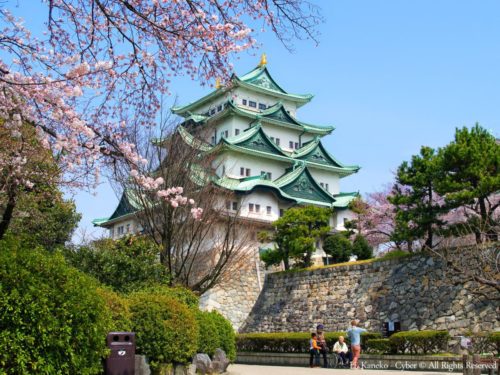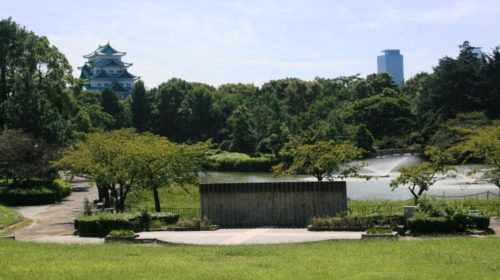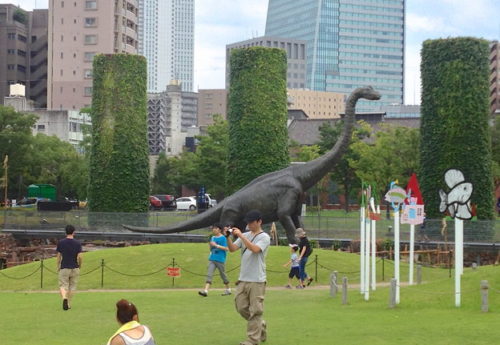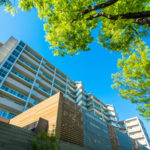3 Must-See Nagoya Castle Attractions| Prices, How to Get There, Surrounding Attractions and More
2019.01.23
- Tags:
-

Planning a visit to Nagoya? Whether your trip is for business or holiday, the renowned Nagoya Castle is the best spot to enjoy everything that Nagoya has to offer.
Along with Osaka Castle and Himeji Castle, the castle is considered one of the Three Great Castles of Japan. It’s designated as a special historic site and is also known for its nicknames such as “Meijo” and “Kinjo.”
Not a history whizz? No worries. This list includes the most important facts about Nagoya Castle as well as what not to miss when visiting.
We’ve also included information about surrounding attractions and how to get to them, so if you’re planning a visit to the Castle, you're in the right place!
Contents
A History of Nagoya Castle – Sengoku Period to Post-War
During the Sengoku Period, the current Nagoya Castle area was ruled by the Imagawa Nagoya clan, known as the Conquerer of Tokai (Tokai no Hasha). Here, the father Imagawa Ujichika established Yanagi-no-Maru, a precursor castle that would later become Nagoya Castle.
At the time, Yanagi-no-Maru was a very small building, hardly recoginzable as a castle.
In the year 1532, it was taken over by Oda Nobuhide, but the Imagawa Nagoyas’ name stuck and the castle was renamed Nagoya Castle.
The castle was later passed on to Nobuhide’s son Nobunaga, and then from Nobunaga to Nobumitsu, after which it was deserted.
Following a blank period, the foritication of the current Nagoya Castle was decided by Tokugawa Ieyasu in the Edo Period, in preparation for an encounter against Toyotomi Hideyori.
It’s said that Nagoya was chosen from three potential locations (Nagoya, Furuwatari, and Komaki) for its size, which was sufficient for housing large armies, as well as its high safety level from floods.
In about three years, the castle tower (Tenshukaku) was completed, and Nagoya grew into a thriving city under the Tokugawas. The castle was the final strategic piece the family needed to unify the country.
Soonly afterwards however, Japan found itself in the midst of the Second World War. In 1945, Nagoya Castle was struck by an air raid and burned to the ground.
There were plans of restoration of the castle tower in 1957, but the Fire Service Act prevented the reconstruction of wooden buildings at the time.
In order to reduce the burden of the damaged stone wall, a structure called a caisson was used within the base of the castle tower. Elevators were also installed within the castle and outside of the stone wall.
In 1959, the 640-million-yen construction was completed and the current Nagoya Castle was opened to the public.
3 Must-See Nagoya Castle Attractions
The most famous feature of Nagoya Castle is the “Shachihoko.”
It has become an iconic symbol of the castle since being displayed and catching on at exhibitions around Japan, as well as at the Vienna World’s Fair.
Here we’ve picked three must-see attractions when visiting Nagoya Castle. Read on and you’ll realize that it’s not only the Shachihoko that makes the place so great!
Castle Tower (Tenshukaku) and the Golden Shachihoko
The castle tower boasts a multitude of golden Shachihoko (aka Kinshachi) for you to admire.
A huge Kinshachi large enough for a full-grown adult to sit on, is one spot in particular that’s not to be missed.
It’s located on the fifth floor of the tower, and is so popular that there’s often a queue of parents all waiting to get a photo of their Kinshachi-riding children.
The Shachihoko is a mythical creature which was originally thought to protect people from fire.
Quite on the contrary, the first Shachihoko itself burned down when it was hit by an air raid, but the second-generation Shachihoko continues to overlook the city of Nagoya from the roof of the reconstructed castle tower.
The first Shachihoko lives on in the present as the “Maruhachi Monyo Shachikan Tsuki Shin Narigama (Replica),” a 6.6 kg pot displayed within the tower.
※Closed for construction since May 7, 2018. The new castle tower is scheduled for completion in December 2022.
Travel in Time at the Honmaru Goten Palace
Awaiting unexpecting guests at the entrance of the Honmaru Goten Palace are golden tiger and leopard wall paintings, the palace’s greatest attraction.
While the painting-covered space was the entryway to the palace, it was also a room where visitors would wait before meeting the lord.
Upon entrance, guests are welcomed by the luxurious Jorakuden “Ichinoma” and the Omote Shoin “Ninoma” rooms. The reception hall, lined with sliding doors (fusuma) decorated with notable Kyoto and Wakayama sights, was used for meetings and banquets.
You’ll feel like you’ve slipped back in time when admiring the fusuma paintings in each room. The amazing attention to detail is a result of Japan’s master craftsmanship.
Many years after it was reduced to ashes, the Honmaru Goten Palace was just recently restored.
Ten years and a total construction cost of fifteen billion yen saw the palace completed in 2018. Fortunately, various remaining records and documents allowed the building to be reproduced very closely to the original.
The palace is now known as a modern castle masterpiece, along with Kyoto Nijo Castle’s Ninomaru Goten Palace.
Flowers and Trees of the Four Seasons
The grounds of Nagoya Castle are full of flowers and trees troughout the year making it a great walking course, regardless of when you choose to visit.
Season Plants to See
Spring Yoshino cherry
weeping cherry
Summer hydrangea
Autumn fragrant olive
Winter sasanqua
Visitors will feel the start of spring when the two plum groves come into bloom. During this season, the cherry blossoms are lit up at night, creating a truly magnificent flower-castle collaboration.
You don’t want to forget about autumn either, when the colorful foliage will engulf the castle tower. Passersby will stop in their tracks to admire the leaves elegantly overlooking the grounds.
Thanks to the variety of flowers throughout the year, each season respectively sees a crowd of visitors.
Admission Fees and How to Get There
In this section you’ll find details about admission fees as well as how to reach Nagoya Castle by car or train.
If you plan on using any other form of transportation, visit the official website or other reliable source for more information.
Admission Fees
Tickets are largely divided into “Adult,” “Nagoya City Senior Citizen※,” and “Junior High School and Younger.” If you’re in a group, you may be subject to discount depending on how many are in your party.
※Nagoya City Senior Citizen: Resident of Nagoya, age 65 and above
Regular Admission Individual Group (30 or more) Group (100 or more)
Adult 500 yen 450 yen 400 yen
Nagoya City Senior Citizen ※ 100 yen 90 yen 80 yen
Junior High School
and Younger Free
Tokugawaen Combination Tickets, which can be used on your day of choice, as well as 1 Year Passes are also available.
Combination Ticket 1 Year Pass
Adult 640 yen Adult 2,000 yen
Nagoya City Senior Citizen ※ 160yen Nagoya City Senior Citizen ※ 600 yen
How to Reach Nagoya Castle (Car / Train)
Now here’s how to actually get there. Information is for car and train travel.
By Car Exit “Kurokawa” of the Nagoya Expressway Route No.1 Kusunoki Line, 8-minute drive south.
Exit “Marunouchi” of the Nagoya Expressway Ring Route, 5-minute drive north.
By Subway 5-minute walk from Meijo Line “Shiyakusho (City Hall)” Exit 7.
12-minute walk from Tsurumai Line “Sengencho” Exit 1.
By Meitetsu (Train) 15-minute walk from Seto Line “Higashiote.”
Parking
Nagoya Castle has it own designated parking lot. There is no maximium charge.
Vehicles Standard Passenger Cars
Motorcycles
Scooters/Mopeds
Dates January 2 – December 28
Hours 8:45 AM – 9:30 PM
※Open until 10:00 PM during the Summer Night Festival.
Capacity 319
Time Fee
Standard Cars Every 30 min 180 yen
Motorbycles and Scooters/Mopeds Every 30 min 100 yen
Surrounding Attractions to Visit
Once you’ve finished exploring Nagoya Castle, you might also want to stop by some other surrounding attractions.
There’s plenty to choose from, as various natural and commercial tourist spots have been popping up around the castle.
If you’re a foodie or would rather sit down and relax, restaurants and cafes are aplenty as well.
Here are our favorite nearby attractions to visit on a Nagoya Castle side trip.
Meijo Park
Meijo Park is a nature-rich park spreading out around Nagoya Castle.
The seasonal scenery and attractions such as the Ofuke Ike Pond let visitors forget that they are actually in the center of one of Japan’s largest cities.
The park boasts a baseball field, tennis courts, and other sports facilities, as well as some unique spots like the Flower Plaza garden.
It’s especially busy during the spring when food stalls and cherry blossoms liven up the night.
Everything you could want in a park is here. You’ll even find a cafe, a running station, massage services, and showering facilities.
Meijo Park is an oasis for Nagoya citizens as much as it’s a tourist favorite.
If you’re looking to enjoy a coffee or relax in nature, this is the place to go.
Meijo Park General Information
Address 1-2 Meijo, Kita, Nagoya, Aichi
Nearest Station Nagoya Municipal Subway Meijo Line “Meijo Koen”
How to Get There 3-minute walk from “Meijo Koen” Exit 2

Noritake Garden
Another must-see attraction in the Nagoya Castle area.
Noritake, the first Western style tableware company in Japan to export dinner sets, created the Noritake Garden in commemoration of its 100-year anniversary.
Built adjacent to Noritake headquarters, the red brick building houses various attractions. The Noritake Square Nagoya shop for tableware, a restaurant serving creative French cuisine to enjoy those special plates, and even a museum offering painting and factory tour experiences.
Especially popular is the outlet shop, where you’ll find a splendid array of products, from everyday plates to high-end ceramics.
The garden also offers areas like the Chimney Plaza and Fountain Plaza to relax. Make sure to stop by if you’re into shopping or want some unique souvenirs.
Noritake Garden General Information
Address 3-1-36 Noritakeshinmachi, Nishi, Nagoya, Aichi
Nearest Station Nagoya Municipal Subway Higashiyama Line “Kamejima”
How to Get There 5-minute walk from “Kamejima” Exit 2

In Conclusion
Nagoya Castle is undoubtedly the city’s top attraction, but there are many more attractions in the area that visitors will love. The ones we listed today are just a few examples.
Of course, if it’s your first time in Nagoya we recommend starting off with the classic Nagoya Castle route to see the Sachihoko and Tenshukaku tower.
But if you’re looking to go a little off the beaten path and find some new Nagoya gems, do pay a visit to some of the surrounding attractions as well.
Share this apartment details











